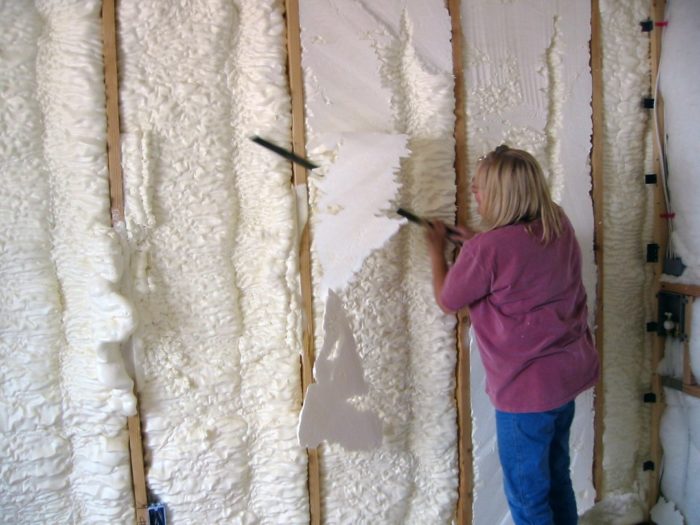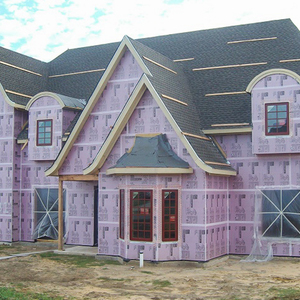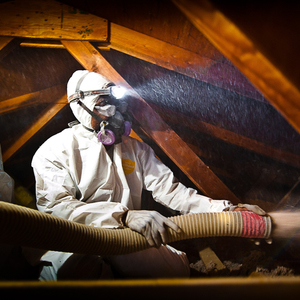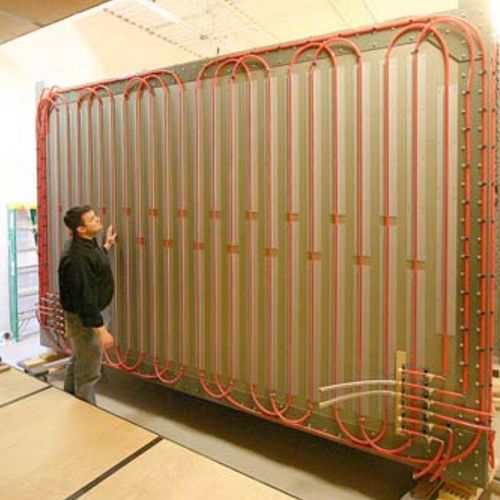
Image Credit: National Renewable Energy Laboratory
Builders who run the other way when someone suggests using fiberglass batt insulation may want to rethink their point of view. A study released by an industry trade group says that one type of wall insulation performs as well as any other as long as it is installed correctly and the wall has been air-sealed.
That conclusion comes from an updated Thermal Metric Summary Report compiled by the Building Science Corporation and released this week by the North American Insulation Manufacturers Association (NAIMA), a trade group representing manufacturers of fiberglass, rock wool, and slag wool insulation.
“R-value is R-value,” NAIMA said in reporting the latest results of the multi-year study. “When walls are constructed to the same R-value and properly sealed, all insulation types perform essentially the same.”
Old news
The findings aren’t new; they were reported by GBA in a September 2012 article called “Air Leakage Degrades the Thermal Performance of Walls.” In that article, senior editor Martin Holladay wrote, “If the walls were sealed and there was no air flow through the walls, all of the R-13 walls behaved the same. As Gertrude Stein might have put it, an R-13 wall is an R-13 wall is an R-13 wall. ‘When the nominal R-13 walls are sealed and tested, they have the same heat flow, plus or minus 4%,’ said [Chris] Schumacher. ‘They all perform roughly the same.’”
A preliminary version of the report was released almost two years ago, NAIMA said, comparing fiberglass batts, cellulose, closed-cell spray foam, and foam sheathing. But open-cell spray foam wasn’t included because of defects in a test wall. The updated version of the report, dated June 2015, also includes test results involving R-15 fiberglass batts and R-15 blown-in fiberglass insulation.
NAIMA said that R-15 fiberglass batts performed better than a wall insulated to R-13 with open-cell spray foam and better than R-12 worth of closed-cell foam.
“The results of this research clearly demonstrate that there is no single ‘best’ insulation material and that all insulation materials perform equally well when properly air sealed and installed, debunking the claims that spray foam insulation performs better than other insulation types and provides air sealing for the whole building.”
Search continues for an R-value replacement
The industry-funded research is part of what’s turning out to be a very long process aimed at replacing R-value with another metric for describing thermal performance.
Joseph Lstiburek, a principal at Building Science Corporation (BSC), announced in 2007 that it was time for the R-value to be retired and replaced with a metric that took into account more complexities of building assemblies and site conditions. As GBA’s Martin Holladay reported nearly four years ago, BSC built a new test rig called a double-guarded hot box with the aim of measuring heat and mass flows. But testing dragged on for years without any firm conclusions.
As the report notes, BSC joined with six companies in the industry — including NAIMA and Icynene, a manufacture of open-cell foam — to develop a replacement for R-value.
“The Thermal Metric Project was initiated in response to renewed focus on building system performance and increasing use of a broader range of building materials and systems,” the report notes. “These factors highlight the shortcomings of the dominate thermal performance metric, namely R-value. Contemporary insulation materials and systems are more or less sensitive to thermal bridging, workmanship (i.e. quality of installation), internal convention and through convection (i.e. infiltration, exfiltration, wind washing and re-entrant looping).
“The impact of such ‘anomalies’ and ‘defects’ is not captured in the standard (label and installed) R-value metric,” it said.
Researchers still have more work to do: “At this stage of the research project, the industry partners have not proposed a new metric for quantifying the thermal performance of insulation beyond conventional R-value,” NAIMA said, “and the report does not include any recommendations for a new metric.”
But the study did yield a number of observations:
- Unless a continuous layer of insulation is installed on one side of the wall, all wood-framed walls are subject to thermal bridging, regardless of what type of insulation is used in the stud cavities. Thermal bridging through the framing lowered thermal performance by about 15%.
- Commercially available heat transfer models do a good job of predicting thermal bridging, as did the ASHRAE Handbook of Fundamentals.
- All types of insulation show changes in thermal performance with changes in temperature.
- No matter what type of insulation is used, all wall assemblies show some loss of thermal performance when air is permitted to move through them.
Weekly Newsletter
Get building science and energy efficiency advice, plus special offers, in your inbox.















13 Comments
NAIMA is trumpeting just one aspect of a complicated study
Thanks for this report, Scott.
It should come as no particular surprise that the trade organization representing fiberglass batt manufacturers (NAIMA) should be trumpeting just one aspect of this complicated study -- "all insulation types perform essentially the same" -- and failing to point out that in the field, most installations of fiberglass batts occur in appallingly leaky homes.
The most important finding of this study is that "air sealing matters," not "all insulation types perform essentially the same."
Full report is worth a look
The full 150 page "summary" report is worth a look. There's a lot more in there. Some highlights for me were that yes, cellulose decreases infiltration better than fiberglass, but the decrease is pretty small, not nearly as good as open-cell spray foam.
And the bullet point:
"All types of insulation show changes in thermal performance with changes in temperature."
was much less interesting than the actual plot of the results they got in testing that, which show almost the same trend for all types except polyiso. Everything else gets better in the cold, worse in the summer, but they show polyiso doing really poorly at low temperatures.
Also interesting is the fact that conduction and infiltration are not simply additive effects when the infiltration goes through the insulation.
Don't discount dense-pack air sealing (response to Charlie, #2)
They only tested damp sprayed cellulose, which doesn't have the same inherent air-sealing aspects of dense packing. With dense packing the material is installed in such a way that it pressurizes the stud cavity, and the escaping air drags cellulose into any air-leak paths, whereas with damp spraying it isn't. It's a safe assumption that a dense-packed wall will have substantially lower air leakage than a damp-sprayed wall unless they air-sealed the wall via other methods first.
But since they did not test dense-packed cellulose or dense packed fiberglass in the initial round of tests, we can't say just how much tighter it really is. Experience with retrofits would indicate that it's significant, but without the side-by-side test it's still an open question.
In Appendix A they tested dense packed fiberglass and compare it to high density batts, but in those tests all framing elements were caulked to the sheathing with latex-caulk in each assembly, which isn't the same conditions as the earlier air leakage testing, which were not caulked.
They seem to be saying
They seem to be saying insulation that is installed like the lab test performs like the lab test. I guess if you have no news then make news, even if you have to repeat a truism.
My 2 cents
Martin wrote:
>The most important finding of this study is that "air sealing matters," not "all insulation types perform essentially the same."
To me, the latter finding is at least as important as the former because (a) I think it's well understood among the folks who pay attention to reports like this that air sealing matters, and (b) not all home performance practitioners understand, or at least act like they understand that all insulation types perform similarly at a given nominal R-value.
Some of us have been saying for a long time that if you assume a tight cavity and uniform insulation (admittedly big assumptions), then R-value is R-value. Period. Everyone who sells or advocates a particular type of insulation loves to point to poor installation practice of all the "other" types. And it's certainly true that there's a lot of crap out there. But if a thoughtful person wants to know what insulation provides the best value and comfort, it's necessary to start with a specification that will ensure a tight envelope (not just the cavity) and will ensure the uniformity of the insulation. This can be achieved with every insulation product, so it all boils down to what it costs to get there. And that's going to depend on the design of the home, the available subs and local pricing.
I see this report, especially the R-value is R-value part, as strong validation to the "one size does not fit all" argument, and refutes those who dare to suggest that one product is generally superior. When you have a hammer, every problem looks like a nail.
In my own experience modeling and specifying envelopes throughout the country is that the best value is often a combination of fibrous insulation (typically blown or sprayed) with conventional air sealing techniques. But I would never argue that's the only approach. Especially when working on projects in rural areas, the requisite skills may simply not be available. I generally avoid spray foam due to the higher cost-benefit compared to other options but I don't hesitate to specify spray foam when it's the best option. Anyway, that's my 2 cents.
Response to David Butler
David,
Thanks for your perceptive comments. I agree that the finding that, when air leakage is controlled, all insulation materials can achieve the R-value on the package label is important -- which is why GBA has been reporting that fact for years.
Like you, I'm not a big fan of spray foam, but I know that it has its applications.
Blown-in cellulose or blown-in fiberglass are often the best choices for walls and attics, and those are the insulation materials that GBA often recommends. We repeat the same phrase until we are sick of repeating it: "Pay attention to airtightness."
Fiberglass batts are problematic -- not because they can't attain the R-value on the package, but because it is so difficult to install them properly. Only a small percentage of fiberglass batt installations follow the manufacturers' installation instructions.
Problematic proper install
Martin,
You hit the key problem with fiberglass batts in your statement "Fiberglass batts are problematic -- not because they can't attain the R-value on the package, but because it is so difficult to install them properly. Only a small percentage of fiberglass batt installations follow the manufacturers' installation instructions."
The reality is that even in a well air sealed building, the effectiveness of the batts is reduced due to the difficulty of installing in bays with wiring, plumbing, and other obstructions that lend themselves to compressed batts and voids.
With Time=Money, in many cases the proper care to install a difficult product isn't given. A product that is an easier (proper) install lends itself to a good installation and performance
I would really be interested in seeing NAIMA including what the percentages were for "proper" installations of the various types of insulation, and the effective R value of actual installations--not lab installations. This would give a better picture
Re: Problematic Proper install
Maybe each type of insulation should have a "factor" that addresses the odds of proper installation? So fiberglass batts would be R-3/inch with a 0.25 install factor, giving them a real world R-0.75/inch. Cellulose might be R-4/inch with a 0.8 install factor resulting in real world R-3.2. Just a thought.
Who decides on the install factors? Good question!
So did I just waste my money?
So if I understand this correctly, fiberglass batts if installed correctly in my stud bays (which were sealed properly) would have insulated my house just as good as the roxul batts I spent a lot more on? If this is true then going forward I will use fiberglass batts on stud bays that have no plumbing, electrical, etc penetrations and use the roxul in areas that would be difficult to do fiberglass properly.
Response to Matthew Seabolt
Matthew,
If you are doing the insulation yourself, and if you are confident in your abilities to do a perfect job when installing fiberglass batts, and if you have developed a way to provide an air barrier on all 6 sides of each cavity where fiberglass batts will be installed, then it is certainly true that R-15 fiberglass batts will perform just as well as R-15 mineral wool batts.
If you are a normal human, you will find it easier to cut and install mineral wool -- and to do a good job of installation -- than you will find it to cut and install fiberglass batts. But if you are a conscientious installer, and you want to save money, fiberglass batts are the way to go.
Other Roxul advantages
Matthew,
There are other advantages to Roxul that just as insulation and easier to install - fireproof (melts above 2000 degrees F - http://www.roxul.com/stone+wool/overview/faq) and more effective at reducing sound transmission. Roxul doesn't claim to be more rodent resistant, but anecdotal reports suggest that it is.
So I would say, no, you did not waste your money.
Interesting discussion. I am looking for the cheapest way to insulate my retirement home that I am planning to build, to passive house standards. Fiberglass batts are horrible to work with. My brother calls them something which translates as approximately disagreeable wool but is much funnier in french. But maybe the problem is more the plumbing and wiring than the insulation. Maybe a dedicated utility channel at floor level, properly insulated would leave a more level playing field for the comparison of insulation products. What I call the utility chase shows up in hay bale houses, but maybe it is applicable to other insulation types. That being said I think mineral wool, being easier to install and hydrofuge (opposite of hydrophilic) and more structurally stable than fibreglass, in the event of accidental breakage of the vapour barrier would win out over fibreglass.
Nils,
The opposite of hydrophilic in English is hydrophobic. I'm not sure whether hydrophobic is an exact translation of the French word "hydrofuge," however.
Mineral wool is not "the cheapest way to insulate your retirement home," but many builders prefer it to fiberglass.
For more information on utility chases, see "Service Cavities for Wiring and Plumbing."
Log in or create an account to post a comment.
Sign up Log in